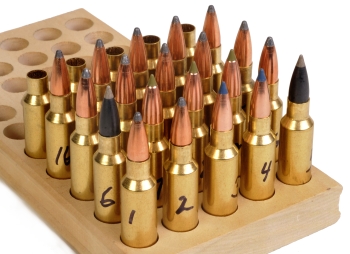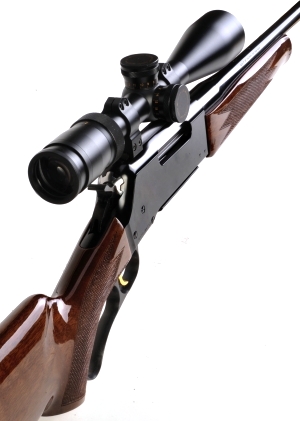
Mounting a scope on the BLR is an easy proposition. Major suppliers offer aftermarket bases and rings and Browning offers a one piece scout base as an accessory for the rifle. The scout base, #12326, is a nicely finished piece that is held in place with screws and a locator pin and offers multiple positions for ring placement. The gun’s rear sight must be removed to install the scout base.

Alternatively, Warnes makes a set of Maxima series low profile symmetrical bases #M838/838M, that will clear the gun’s hammer with medium height rings. Using a scope with a 42mm objective required removal of the gun’s barrel mounted rear sight for clearance. I went with the Warnes set up because I feel that the rifle/cartridge combination has too much potential to handicap with a scout scope set up.  A 2-10x42mm scope was installed for this portion of the project. Regardless the base type selected, the gun with scope attached could still be taken down.
A 2-10x42mm scope was installed for this portion of the project. Regardless the base type selected, the gun with scope attached could still be taken down.
Based upon experience accumulated with a Browning bolt action 325 WSM, the BLR was tested with a six bullet standard and Winchester factory ammunition. Bullet weight ranged from 150 grains to 220 grains with jacket and bullet construction suitable for the 325 WSM, when used within each manufacturer’s recommended applications. Bullets appear in order on the table as pictured above.
Wish I lived in Florida…
 Yesterday the temperature was 55°F, so I of course stayed indoors, took pictures and wrote. Today it was 22°F, a day before deadline, so I had to go out and shoot… in the snow… driving winds… running nose… Let me start by thanking the people at Browning for designing a firearm that permits safe shooting with a gloved hand.
Yesterday the temperature was 55°F, so I of course stayed indoors, took pictures and wrote. Today it was 22°F, a day before deadline, so I had to go out and shoot… in the snow… driving winds… running nose… Let me start by thanking the people at Browning for designing a firearm that permits safe shooting with a gloved hand.
In addition to factory ammunition, the handloads noted below were assembled in a pretty straightforward and they don’t stray very far from data that appears in component manufacturer’s reloading manuals.
 Warning: Bullet selections are specific, and loads are not valid with substitutions of different bullets of the same weight. Variations in bullet material and length will alter net case capacity, pressure and velocity results. Primer selection is specific and primer types are not interchangeable. These data represents maximum loads in our firearms and test equipment and may easily be excessive in other applications. All loads should be reduced by 3%, and developed following safe handloading practices as represented in established reloading manuals produced by component manufacturers. Presentation of these loads does not constitute a solicitation for their use, nor a recommendation. Warning: Bullet selections are specific, and loads are not valid with substitutions of different bullets of the same weight. Variations in bullet material and length will alter net case capacity, pressure and velocity results. Primer selection is specific and primer types are not interchangeable. These data represents maximum loads in our firearms and test equipment and may easily be excessive in other applications. All loads should be reduced by 3%, and developed following safe handloading practices as represented in established reloading manuals produced by component manufacturers. Presentation of these loads does not constitute a solicitation for their use, nor a recommendation.
|
|||||||||||||||||||||||||||||||||||||||||||||||||||||||||||||||||||||||||||||||||||||||||||||||||||||||||||||||||||||||||||||||||||||||||||||||||||||||||||||||||||||||||||||||||||||||||||||||||||||||||||||||||||||||||||||
|
|||||||||||||||||||||||||||||||||||||||||||||||||||||||||||||||||||||||||||||||||||||||||||||||||||||||||||||||||||||||||||||||||||||||||||||||||||||||||||||||||||||||||||||||||||||||||||||||||||||||||||||||||||||||||||||
Handloading the 325 WSM is what I would refer to as uneventful. Working with new Winchester brass, passed through a full length sizer, trimmed and chamfered, no special attention was required. There careful selection of magnum primers over standard was based on having more magnum primers in inventory.
 Right up through 220 grain bullets, Alliant’s Reloder 17 (ATK’s spelling, not mine) and Hodgdon H414 was easily the best in terms of velocity. IMR 4350 became an alternative when I got to the longish Nosler 180 grain E Bullet and remained so through 220 grain, but it was not exceptional. I did create a modest velocity, very low recoil deer load with 150 grain Hornady bullets and IMR 4350 powder, which makes the gun and cartridge combination certainly flexible enough for East Coast whitetail deer hunting. Factory Winchester Supreme, far left.
Right up through 220 grain bullets, Alliant’s Reloder 17 (ATK’s spelling, not mine) and Hodgdon H414 was easily the best in terms of velocity. IMR 4350 became an alternative when I got to the longish Nosler 180 grain E Bullet and remained so through 220 grain, but it was not exceptional. I did create a modest velocity, very low recoil deer load with 150 grain Hornady bullets and IMR 4350 powder, which makes the gun and cartridge combination certainly flexible enough for East Coast whitetail deer hunting. Factory Winchester Supreme, far left.
All of the bulleted noted are designed for a minimum impact velocity of 1,800 fps. The E-Tip with its solid copper construction and all heavier weight bullets can sustain any maximum impact velocity any 8mm cartridge can dish out. Subsequently, the 180 grain bullets with the exception of the E Tip are recommended only for deer and antelope. The E Tip and heavier weights are recommended for deer, elk, moose, brown bear, and similar size African game. That’s quite a spread on application, which makes the 325 WSM and Browning BLR one heck of a combination. Nosler, in particular, does a good job of covering the 325 WSM.
 The 22″ barrel BLR was shot along side a 23″ barrel A-Bolt. With moderate charges, fast or slow powder, the difference was negligible. With Winchester Supreme 180 grain Ballistic Silvertip ammunition, the difference was a consistent 52 fps with the checkered flag going to the A-Bolt at 3096 fps.
The 22″ barrel BLR was shot along side a 23″ barrel A-Bolt. With moderate charges, fast or slow powder, the difference was negligible. With Winchester Supreme 180 grain Ballistic Silvertip ammunition, the difference was a consistent 52 fps with the checkered flag going to the A-Bolt at 3096 fps.
Accuracy, cold or hot barrel, was excellent, although ambient temperatures prevented any appreciable barrel temperature rise. I was going to construct a big table and plot shift in point of impact caused by the barrel being removed and reinstalled but, essentially, there was none.
The BLR seemed to kick less than the A-Bolt, but both got my attention. The BLR’s lever effort was low, regardless the handload, and there was never a time the magazine was hard to fill or insert. Access to the hammer under the scope was good; no fumbling even with gloves, and the folding hammer safety is a nice feature. Compared to a conventional lever action rifle, the bolt glided as though it were running on ball bearings. Report and recoil are… stout. Not 375 H&H stout, but 300 or 338 Winchester Magnum stout. Powerful gun… recoil to follow.
I think we went to different schools together…

Browning has been around for such a long time. Since 1880 in one form or another. Their firearms are an American presence, as well as a worldwide presence. Within the current line of centerfire rifles, the BLR is a standout. Quite evolved from the 1971 initial release, the gun is stronger, lighter and more accurate than any of its predecessors. The 325 WSM makes the BLR a true heavy hitter with lots of reach for big game hunting, while the gun remains light enough to not create an unnecessary burden for the person who has to haul it around. It is a precise piece of machinery, nicely finished… something a little special to hold onto for a long time.
Browning’s Lightweight BLR Takedown Part 1
Browning’s Lightweight BLR Takedown Part 2

Email Notification